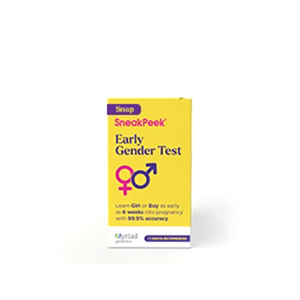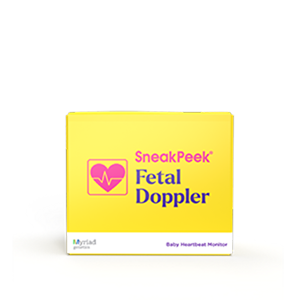Published on October 10th, 2021 and Updated on January 15th, 2024
Check out SneakPeek Gender Test to find out your baby’s gender as early as 6 weeks at over 99% accuracy1!
When you lay your newborn or little one to sleep after a warm bath, a lullaby, and a final whiff of that sweet baby smell, you can rest easy knowing he’s snoozing safely and soundly in his crib. But if your baby is rolling onto his side during sleep, rather than staying on his back, you may wonder,
Is baby sleeping on side safe?
Although the American Academy of Pediatrics (AAP) recommends placing your baby on his back to sleep until he’s 1 year old, the AAP also states that it’s perfectly safe to let your baby roll onto his side during sleep, as long as he’s over 4 months old and has developed the strength and motor skills to roll onto his side on his own.
Understanding Baby Side Sleeping
At 4 months old, your baby has likely:
- Started to grab at items within her reach (whether it’s her favorite toy or your freshly washed hair)
- Discovered she can put objects in her mouth for an exploratory taste test (again, whether it be her toys or your hair)
- Developed strong enough neck, arm, and upper body muscles to lift her head on her own and roll over onto her tummy
Not only do these developments showcase how quickly babies grow, but they also indicate your baby’s individual preferences. When it comes to sleeping, you may notice your baby turning onto her side to fall asleep once she’s developed the ability to roll over.
While the AAP recommends placing babies younger than 1 year old on their backs to sleep, if your baby is strong enough to turn onto her side without assistance from mom or dad, she’s also strong enough to turn back over. This means your little one is safe to sleep on her side.
However, regardless of development, the AAP still recommends placing your child on her back to sleep until she’s over 1 year old. The supine position is also the best sleeping position for a gassy baby because you can gently massage his stomach and encourage him to release gas.
Why Back is Best
If you’re wondering why a baby sleeping on his back is suggested over other sleeping positions, we are here to help. While your partner’s back-sleeping may encourage freight train-esque snoring, your baby’s back-sleeping will encourage the safest slumber possible. This is because back sleeping significantly reduces the likelihood of sudden infant death syndrome (SIDS), as well as certain medical conditions such as torticollis and harlequin color change.
Don’t worry—we have translations below.
Sudden Infant Death Syndrome
One of the major risk factors of SIDS is stomach sleeping. This is because stomach sleeping increases your baby’s risk of suffocation, particularly if he’s swaddled during sleep or if he’s unable to roll over on his own (swaddled or not).
If you place your little one on his back to sleep, he’s unlikely to roll onto his stomach during the night, especially if he’s younger than 4 months and hasn’t developed the motor skills to roll over on his own. However, if you place your baby on his side to sleep, he’s much more likely to accidentally roll onto his stomach. If he’s swaddled or if he doesn’t have the proper rolling motor skills, he’ll be unable to roll himself back over, increasing his chances of suffocation. And
By always placing your baby on his back, you can prevent accidental suffocation, even if he happens to spit up during the night. This is because babies have an automatic reflex that causes them to cough up or swallow spit-up, even while on their backs (which helps explain your baby’s expansive “spit-up splash zone” during the day).
Torticollis
If an unusual sleeping position has ever left you with pain that makes it difficult to turn your head, you’ve experienced torticollis—a condition caused by excessive tilting or twisting of the neck. Symptoms of torticollis can include:
- Limited range of motion in the neck
- Inability to turn the head
- Tilting of the head to one side
While congenital torticollis is usually due to improper womb positioning, acquired torticollis is most often the result of side sleeping.
When your baby sleeps on her side:
- Her head is tilted at an angle
- Her neck is less supported
In the first 3 months after birth, head and neck support are particularly important for proper bone and muscle development. So it’s best to follow the AAP’s recommendation, and avoid placing your little snoozer on her side to sleep.
Harlequin Color Change
Although harmless, harlequin color change can be shocking for any parent to see. During harlequin color change, half of your baby’s face and body become a shade of red. This condition occurs in roughly 10% of healthy newborns who sleep on their sides because the blood pools in smaller blood vessels on the side of the body they’re lying on.
As your baby grows, the pooling and subsequent color changing of the skin will stop (which is why children and adults don’t wake up half pink). But in the meantime, it’s best to keep your baby on his back instead of in the prone position to ensure his safety and maintain his healthy, appropriately-skin-toned glow.
Tips for Safe Sleeping
A safe sleeping environment goes beyond sleep position. With the following safe sleeping tips, your baby’s crib will be as protective as it is peaceful:
- Choose a firm mattress – If your baby is sinking into her mattress, it’s easier for her to accidentally roll onto her side (and then onto her stomach) during sleep.
- Avoid using an infant sleep positioner – While these devices were designed to keep babies on their backs during sleep, they actually pose a suffocation risk. The only object that should be in your baby’s crib is your baby.
- Invest in a video monitor – A video monitor allows you to check that your precious little angel hasn’t accidentally rolled onto her side during sleep, without risking waking her up by entering her room (and experiencing those not-so-precious disrupted sleep screams).
- Only swaddle your baby until she can roll over – Because swaddling constrains your baby’s arms, this practice should only be done until your baby can roll over on her own (which typically occurs around 4 to 6 months). If your baby rolls over while swaddled, she won’t be able to use her arms to lift her head or roll back over, increasing her risk of suffocation. Once your baby can roll over, consider using a sleep sack. It will provide the same comfort as a swaddling blanket, but leaves your baby’s arms free so that she can roll over without risking suffocation.
What about flat head syndrome?
Some parents may worry that consistent back sleeping may lead to plagiocephaly—otherwise known as flat head syndrome. It’s a condition that’s defined by a flat spot on the back of your baby’s head. This condition is actually quite common, affecting nearly 50% of babies, because your baby’s skull remains soft until several months after birth. It’s your baby’s pliable bones that made it easier for him to move from womb to world (not to mention, easier for mom).
These soft bones also make it more likely for your baby to develop a soft spot on the back of his head if he regularly sleeps in the same position at night (i.e., with his head flat against the mattress).
While flat head syndrome generally doesn’t pose developmental risks and will eventually go away on its own, keep an eye out for further irregularities which could indicate a more severe case. These include:
- Misaligned eyes or ears
- Hard ridges on the head
- Slants along the side of the head
Fortunately, there are steps you can take to help prevent plagiocephaly, including:
- Encourage your baby to turn his head – When your baby is lying flat in his crib, you can encourage him to turn to head to the side by placing a toy or mobile just outside the crib.
- Switch up his crib placement – If you always place your baby with his head at the head of the crib, he’ll likely always turn his head in the direction that faces the rest of his bedroom. To ease the pressure on that side of his head and encourage him to look in the other direction, switch up his crib placement by placing his head at the foot of the crib every other day.
- Provide ample tummy time – During the day, you can give the back of the head a rest by allowing your baby time to explore the world on his stomach. This will also help him develop his neck, arm, and upper body muscles. Just be sure to monitor your little explorer for the duration of his tummy time.
Learn More Sleep Science with SneakPeek
When it comes to ensuring your baby is sleeping soundly and safely, just remember: back is best for the first year. As your little one grows and develops her rolling skills, you may find she prefers to fall asleep on her side. Even if this is the case, you should continue to place your baby on her back, and let her roll onto her side on her own.
If you find yourself with more sleeping questions like “when your baby my can sleep on their stomach”, “what are the best sleeping positions for a congested baby” or even “ what are the best sleep position for a colic baby”, read our linked blogs!
Sources:
- Healthline. Is Side Sleeping Safe for My Baby? https://www.healthline.com/health/baby-sleeping-on-side
- AAP News & Journals Gateway. SIDS and Other Sleep-Related Infant Deaths: Updated 2016 Recommendations for a Safe Infant Sleeping Environment. https://pediatrics.aappublications.org/content/138/5/e20162938
- The BMJ. Sudden infant death syndrome and advice for safe sleeping. https://www.bmj.com/content/350/bmj.h1989
- NIH. Myths and Facts About SIDS and Safe Infant Sleep. https://safetosleep.nichd.nih.gov/safesleepbasics/mythsfacts#:~:text=Myth%3A%20Babies%20who%20sleep%20on,who%20sleep%20on%20their%20backs.
- NCBI. Harlequin colour change: unilateral erythema in a newborn. https://www.ncbi.nlm.nih.gov/pmc/articles/PMC2988569/
- Family Doctor. Plagiocephaly. https://familydoctor.org/condition/plagiocephaly/
- Medical News Today. Baby sleeping on side: Risks and changing positions. https://www.medicalnewstoday.com/articles/baby-sleeping-on-side#summary
- Healthline. Understanding Flat Head Syndrome (Plagiocephaly) in Babies. https://www.healthline.com/health/parenting/flat-head-baby#seeking-help
- The Baby Sleep Site. When To Stop Swaddling Your Baby and 3 Ways to Transition. https://www.babysleepsite.com/sleep-training/how-when-to-stop-swaddling-baby/

Shop Our Products
SneakPeek aims to provide the most accurate and up-to-date information to help our readers make informed decisions regarding their health before, during, and after pregnancy. This article was written based upon trusted scientific research studies and/or articles. Credible information sources for this article are cited and hyperlinked.





